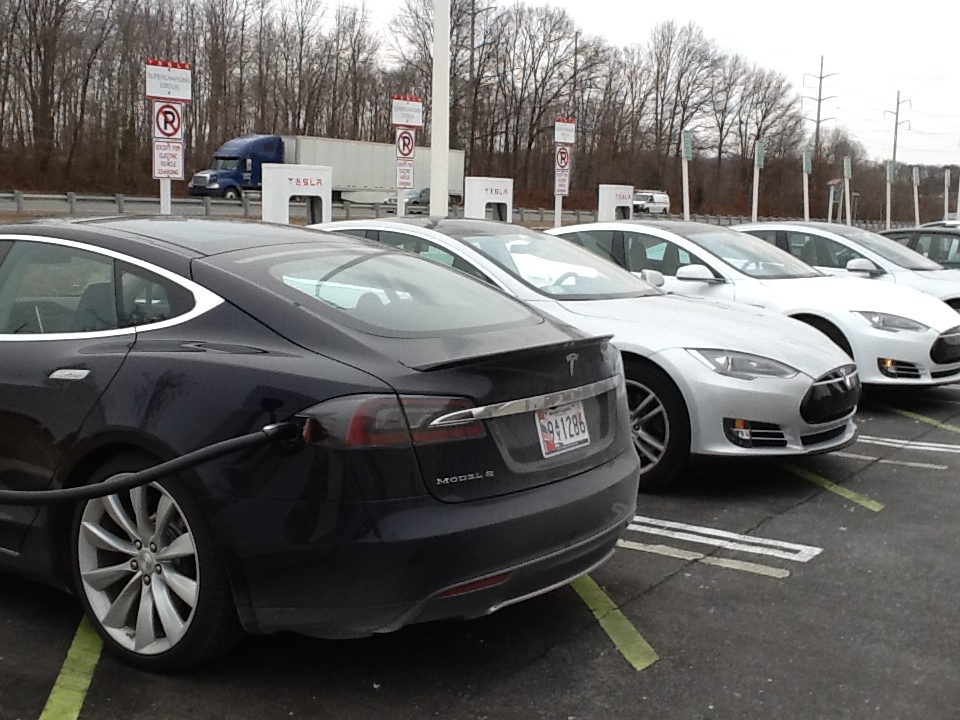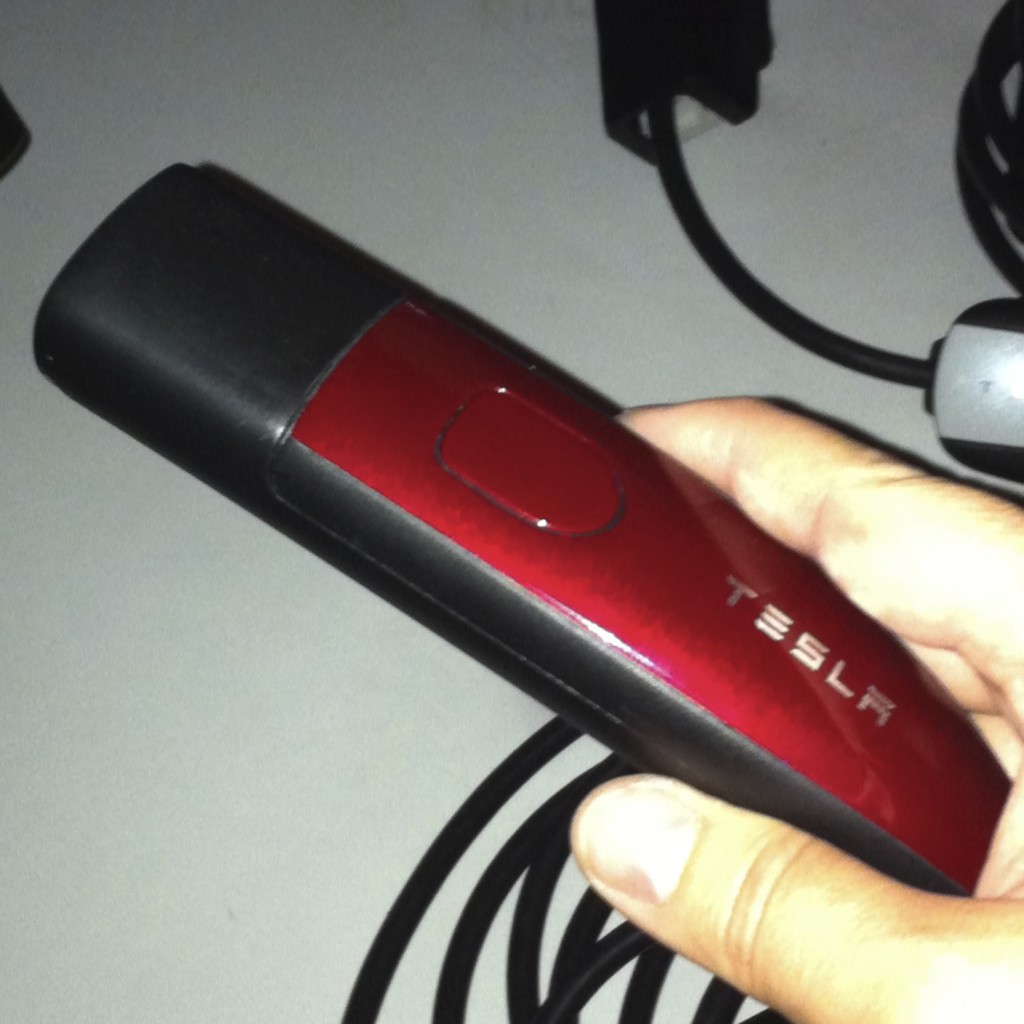![2013 Tesla Model S electric sport sedan [photo by owner David Noland] 2013 Tesla Model S electric sport sedan [photo by owner David Noland]](https://images.hgmsites.net/med/2013-tesla-model-s_100421974_m.jpg)
2013 Tesla Model S electric sport sedan [photo by owner David Noland]
In the eight months I've owned my 60-kWh Tesla Model S, I've never had occasion to drive it more than 120 miles, comfortably within the car's EPA-rated 208-mile range. The phrase "range anxiety" was not in my lexicon.
But last week, I got an invitation from Don Sherman, Technical Director of Car & Driver magazine, to meet him in Danville, Pennsylvania. It's 168 miles from my home in New York's Hudson Valley.
Sherman was making a dry run for an upcoming article about a 700-mile cross-country race in a Model S--and Danville, just off Interstate-80, was going to be a charging stop. We'd e-mailed back and forth about Model S driving and charging strategies, and this would be a chance to meet and compare notes.
The journey seemed short enough to be eminently doable--yet long enough to engender, if not range anxiety, then at least acute range awareness.
Fast and hilly
Although I supposedly had a 40-mile cushion in the 208-mile EPA range, I knew very well that my mileage may vary.
![2013 Tesla Model S [photo: David Noland] 2013 Tesla Model S [photo: David Noland]](https://images.hgmsites.net/med/2011-chevrolet-volt-and-2013-tesla-model-s-photo-david-noland_100427532_m.jpg)
2013 Tesla Model S [photo: David Noland]
I was planning to drive fast, from 70 to 75 mph along the Interstates that made up most of the route. The terrain was hilly. There would be a prevailing headwind. And the advancing fall season promised cooler temperatures.
All of these factors would eat into range.
100-percent charge
In preparation for the trip, I set the battery charge level at 100 percent, the first time I'd done so.
Previously, I'd always used the "standard" setting, 90 percent of capacity. To get a full 100 percent, you set the charger to "range" mode, which Tesla recommends only when maximum range is necessary.
(The reason: Lithium-ion batteries degrade more quickly when charged to 100 percent of capacity.)
A couple of months ago, a software update from Tesla allowed the charge limit to be set at any level. Tesla recommends 50 to 90 percent for everyday driving. I had settled on 75 percent, which was plenty for my normal driving routine.
But for this trip, I set the charger to 90 percent the night before, then topped off the battery to 100 percent before departure the next day. The topping-off process took longer than I anticipated; charge rate dropped from the usual 10 kW to about 3 kW for the last few kilowatt-hours.
As I rolled out of my driveway, on an unseasonably warm Indian Summer day, the range meter read 199 miles.

David and Adam Metcalf beat 400 miles on a charge in a 2012 Tesla Model S (Image: David Metcalf)
Vanishing regen
The first thing I noticed was that the regenerative braking virtually disappeared with the 100-percent charge. Charge rates in max regen can approach 40 kW, way too much for a nearly full battery.
Going down a long, steep hill near my house, I actually had to use the brakes. Damn! Wasting precious energy already!
Fortunately, full regeneration came back quickly, within 10 miles.
Efficiency readouts
I don't have a lot of faith in the Model S range meter. Its number is a projection based on rule-of-thumb efficiency assumptions, battery temperature, and a safety fudge factor. (New York Times reporter Jonathan Broder famously fell victim to wildly fluctuating range numbers.) I call it the guess-o-meter.
Instead, I monitor the dashboard readout of trip efficiency, measured in Watt-hours per mile. During my earlier shorter stints of highway driving, in warm weather, I'd averaged 290 to 300 Wh/mi.
I figured if I could maintain that level of efficiency, I'd make it to Danville with about 30 miles to spare. The Wh/mi reading thus became my prime focus for the trip.
Initial anxiety
For the open stretches of Interstate, I set the cruise control on 74 mph. (I figured no self-respecting cop would stop me for breaking the speed limit by single digits.
Forty miles out, along I-84, the e-meter settled in at around 310 Wh/mi. With the usual minor ups and downs for hills, the number crept steadily upward as I crossed into Pennsylvania. By the time I reached Wilkes-Barre--about halfway--it was reading 330.
Not good.
![2013 Tesla Model S electric sport sedan [photo by owner David Noland] 2013 Tesla Model S electric sport sedan [photo by owner David Noland]](https://images.hgmsites.net/med/2013-tesla-model-s_100421974_m.jpg)
2013 Tesla Model S electric sport sedan [photo by owner David Noland]
At this rate I'd be totally out of energy at 182 miles. Way too close for comfort.
Elevation changes
But I was pretty sure that the culprit was elevation. From previous trips, I'd learned that elevation changes have a huge effect on the range of the Model S.
For example, when I make the 60-mile drive from my house (elevation: 423 feet) to New York City (sea level), I typically average 270 Wh/mi in warm weather. The return trip, slightly uphill, averages about 310. A mere 400-foot elevation change over 60 miles alters efficiency by almost 15 percent.
I'd checked the elevation of Danville (578 feet) before I left, but hadn't paid attention to the intervening terrain. Hopefully, I'd soon begin descending.

Tesla Road Trip from MD to CT, Feb 2013 - Tesla Model S cars at Delaware SuperCharger location
Sure enough, as I passed Wilkes Barre, the e-meter began to come back down toward 320 kWh/mi, then 310. I breathed a sigh of relief; I had it in the bag.
(I later determined that I'd reached a peak elevation of about 1800 feet along I-84 just east of Wilkes-Barre.)
By the time I got to Danville, my energy usage had dropped to 295 wH/mi--right in the middle of my target zone.
The range meter read 24 miles when I finally arrived at a funky farmhouse. It was home to an affable banjo-picker named Mark Doncheski, two Corvettes, and a Tesla Roadster. Mark had agreed to make his Tesla charger available to Sherman and me.
Range meter quirks
As I'd anticipated, the guess-o-meter didn't quite square with reality. I'd started with 199 indicated miles and driven an actual 168. That's a 31-mile difference. Seven miles got lost somewhere.
The old-reliable e-meter told me I'd used 49.4 kWh of juice for the trip. That left 10.6 kWh--enough to drive an additional 36 miles at my trip average of 295 wH/mi. (More, at slower speeds.)
Theoretically, I had 12 more miles remaining than the guess-o-meter indicated.
This squares with an unofficial on-line Model S owner's manual compiled by Tesla fanatic Nick J. Howe. According to Howe, the 85-kWh Model S actually has 17 miles "in the tank" after the range meter reaches zero.
Prorating for my 60-kWh battery, that's pretty close to my theoretical 12-mile buffer.
Bottom line: I can still probably limp to some sort of electrical outlet or charger even after the range meter hits zero. Frankly, I never want to have to confirm that.
Tesla talk
Sherman arrived five hours later in a brown P85, accompanied by owner Fred Glomb and a support truck towing a trailer. Cruising at a steady 62 mph, they'd covered the 251-mile leg from Ohio with 20 miles to spare.
Over a late dinner in Mark's kitchen, we talked Tesla and the upcoming race till well past midnight.

2012 Tesla Model S Charging Connector
Out of the pizza-fueled discussion came a startling conclusion about Model S driving strategy for the race: Cruising speed is basically irrelevant. Any time gained by going faster between charging stops is almost exactly negated by the increased charging time.
(This conclusion assumes an 85-kWh car equipped with Twin Chargers that is charged from a 20-kW Tesla High Power Wall Connector--the fastest possible charging scenario along the race route, which had no Superchargers anywhere near.)
The breakdown: Over a typical 240-mile leg, driving 70 mph would save 56 minutes over a 55-mph speed. Based on the speed-vs-range graph on the Tesla website, the faster car would use about 18 kWh more energy. Charging time to replace that extra 18 kWh: 54 minutes.
Of course the eventual arrival of more Superchargers will eliminate such fascinating threads of discussion.
Next morning, Sherman's car was loaded onto the trailer for the trip back to Michigan. I topped off my car and retraced my route home, logging virtually identical numbers for the return leg.
My personal takeaway from this exercise was a practical range limit for my car: 180 miles in warm weather, 150 miles in the cold.
Bring on the East Coast Superchargers. Please.
_______________________________________________












